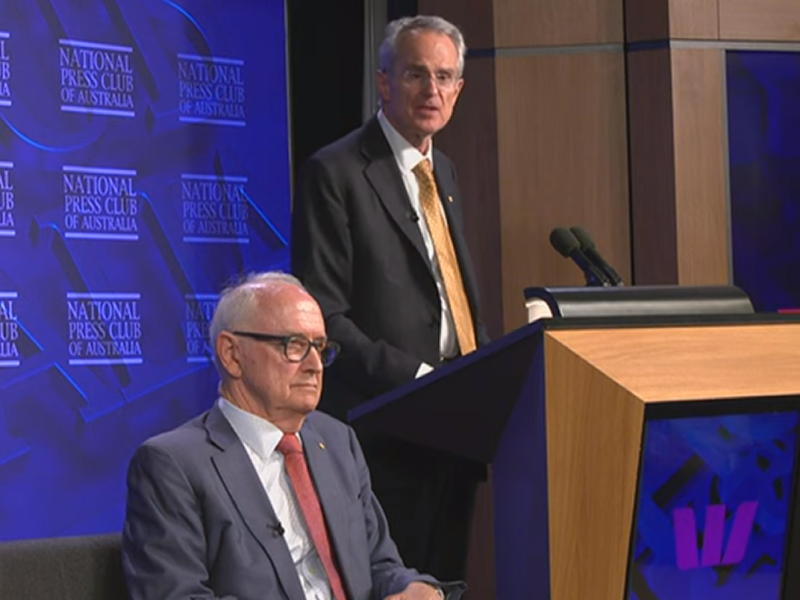Australia’s green energy superpower ambitions need a massive innovation and investment scheme to match, and will only be fully realised with a $100 billion a year carbon levy, according to policy experts Rod Sims and Ross Garnaut.
The call to resurrect carbon pricing comes as the Albanese government finalises its response to the global competition for clean energy industries, which have included both massive public investment and cross-border carbon tariffs elsewhere.
The pair of Hawke government advisors, now the leaders of the Superpower Institute thinktank, said Australia needs a unique approach that capitalises on its comparative advantages by making bold investments in new industries like green iron, green aluminium, green polysilicon, green transport fuels, and green urea.
To support the new export industries, the government needs to prioritise the production of hydrogen from renewable energy for inputs to domestic industry. It would also need to fund the development of hydrogen storage and transport infrastructure and the required electricity transmission, Mr Sims and Mr Garnaut argued at the National Press Club in Canberra on Wednesday.
Treasurer Jim Chalmers has already hinted at significant reforms and investment are on the way to support the green superpower plan and identified four priority areas: critical minerals, energy generation and storage, green hydrogen and green steel.

While launching 15 ‘recommendations for boosting Australia’s prosperity by maximising our contribution to global emissions reduction’, Mr Garnaut said Australia is well placed to become a superpower in a decarbonised global economy because of its vast natural endowments of wind and solar energy resources and the land needed to deploy it. The abundance of land can also be used produce biomass as an alternative input to fossil fuels for chemical manufacturers, he said.
“Our main message today is that export of zero carbon goods can underpin a long period of high investment, rising productivity, full employment, and rising incomes in Australia,” Mr Garnaut said.
Mr Garnaut warned Australia should not seek to duplicate the United States’ flagship green industries policy, the Inflation Reduction Act (IRA), which is offering huge subsidies for domestic manufacturing and clean energy.
“The IRA is turbocharging US decarbonisation… but it’s the embodiment of the Trump-Biden support for eye watering fiscal deficits and protection that is making the US uncompetitive in global markets,” he said.
This is due to the IRA’s “local production requirements and the effects of protection and budget deficits on the real exchange rate [which] may work for an inward focussed approach, but it cannot suit an export focussed Australia”, the recommendations document reads.
According to the think tank’s recommendations, a Superpower Industries Innovation Scheme (SIIS) should be administered by the Australian Renewable Energy Agency (ARENA) to kickstart the decarbonisation plan.
The program should cover up to 50 per cent of capital costs for up to three facilities that plan to use a large amount of renewable energy or biomass> The facilities would offer “learning by doing” benefits to the wider economy that are difficult to capture by the original business.
Mr Sims, who served as Australia’s competition regulator for the decade to 2022, stressed that the “economics have changed”.
“This isn’t ‘process more in Australia’ as some sort of mantra.”
In the decarbonising global economy Australia would no longer export its raw ores but instead focus on green products produced at a low carbon-intensity under the proposal.
The new green industries would capitalise on the ‘green premium’ that will be instituted when the European Union’s Carbon Border Adjustment Mechanism – a tariff on high carbon intensity products – comes into full effect in 2026.
The green premium could also be instituted in Australia through a ‘Carbon Solutions Levy’ – equivalent to the European carbon price – that would apply per tonne of carbon dioxide fir fossil fuel extraction or imported into Australia. The thinktank argues this would generate $100 billion in proceeds in the first year that could be used to fund the SIIS, transmission and hydrogen infrastructure investments, and other recommended initiatives.
“In that world, green iron will out compete fossil iron, so there’s no question that the green products can be economic, if you appropriately impose some fee on the damage done by fossil fuels,” Mr Sims said.
The Minerals Council of Australia immediately dismissed the idea of a carbon levy on Wednesday, with its chief executive Tania Constable labelling it a “blunt” tax on Australian industry.
Mr Garnaut said many countries in Northeast Asia and Europe will only be able to reach net-zero by importing green products that embed the emissions reductions from the renewable energy used to produce it.
“Even if China were willing to pay twice Australia’s expected cost of renewable energy in 2050, it would only satisfy half of its forecast requirements for wind and solar from its own resources. That leaves a gap of over 2000-terawatt hours,” Mr Garnaut said.
“The cheapest way to source that immense amount of energy is by importing goods that embody renewable energy. Turning the iron ore China currently imports from Australia into metal before it is shipped would fill over a quarter of this gap.
“Making that iron metal in Australia would require 10 times the power now used in Australia’s [National Energy Market]. The constraints on domestic supply of renewable energy are even greater in Japan, Korea and Europe than in China.
“The processing of minerals will be the most important of the superpower industries.”
Do you know more? Contact James Riley via Email.

